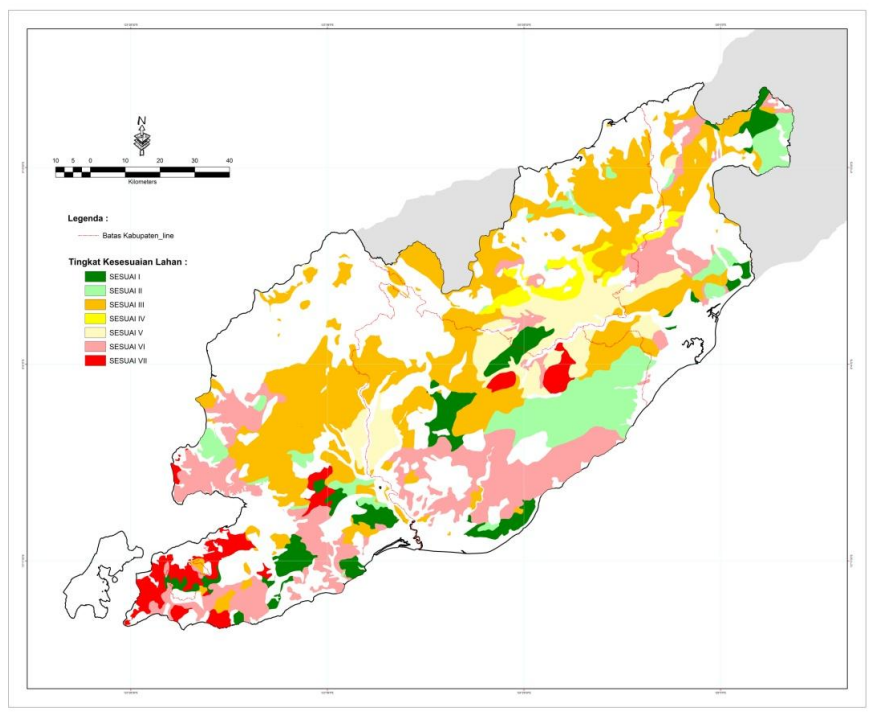Land suitability analysis for sandalwood plantation in Timor island

Downloads
Sandalwood population in Timor Island has been on a decrease at an alarming rate. The decrease reached
85% in 10 years, from 1987-1988 and 1997-1998. The present status of sandalwood on the Timor Island has been included as a vulnerable specie. Sandalwood cultivation and recovery efforts is systematic, this involves a planned process. To achieve any significant success, it must be supported by data and information about the location suitable for the growth of sandalwood. This study aims to provide data and information on the land suitability for
sandalwood (Santalum album Linn.) in Timor Island. The study was conducted by analysis of soil chemistry and physics and biophysical conditions overlay with FAO procedure (1976). The analysis showed an actual suitability area for development of sandalwood in each district are as follows: Belu of 125,216.69 ha (51.32%), Timor Tengah Utara of 163,554.16 ha (61.26%), Timor Tengah Selatan of 278,818.77 ha (70.64%), Kupang of 263,677.77 ha (44.73%), Kupang City of 8994.48 ha (49.89%) of the total land area of each district.
Balai Pengelolaan DAS Benain Noelmina. (2006). Data Base dan Informasi DAS Tahun 2006 Balai Pengelolaan DAS Benain Noelmina Nusa Tenggara Timur. 23p. Kupang: Balai Pengelolaan DAS Benain Noelmina.
Dinas Kehutanan Provinsi NTT. (2009a). Petunjuk Pelaksana Provinsi Cendana. 28p. Kupang: Dinas Kehutanan Provinsi NTT.
Dinas Kehutanan Provinsi NTT. (2009b). Progress Pengembangan Hutan Tanaman Cendana Provinsi Nusa Tenggara Timur Dalam Rangka Mewujudkan Tekad Provinsi Cendana: Kondisi Bulan Juni 2009. 97p. Kupang: Dinas Kehutanan Provinsi NTT.
FAO. (1976). A Frame Work for Land Evaluation (Soil Buletin). Rome-Italy: Food and Agriculture Organization of the United Nations.
Faridah, E., H. supriyo, M.G. Wibisono, Kristinawati, D. Afiani, D. Hartanti. (2012). Akselerasi Pertumbuhan Cendana (Santalum album) Dengan Aplikasi Unsur Hara Makro Esensial Pada Tiga Jenis Tanah. Jurnal Ilmu Kehutanan, 6(1), 1-17.
Haryjanto L. (2007). Konservasi Sumber Daya Genetik Cendana (Santalum album Linn.). Prosiding Gelar Teknologi Cendana “Cendana untuk Rakyat: Pengembangan Tanaman Cendana di Lahan Masyarakat”, tanggal 19 Desember 2006 Puslitbang Hutan dan Konservasi Alam. Bogor. 53-59p.
IUCN. (2010). Santalum album (Sandalwood), IUCN Redlist of Threatened Species. Version 2010.2. www.iucnredlist.org.
Kementerian Kehutanan dan Pemerintah Provinsi NTT. (2010). Master Plan Pengembangan dan Pelestarian Cendana Provinsi Nusa Tenggara Timur Tahun 2010 – 2030. 58p. Kupang: Balai Penelitian Kehutanan Kupang.
Liu, Y.S., J.Y. Wang, and L.Y. Guo. (2006). GIS-Based Assesment of Land Suitability for Optimal Allocation in the Qinling Mountains, China. Pedosphere, 16(5), 579-586.
Neil P.E. (1990). Growing Sandalwood in Nepal – Potential Silvicultur Methods and Research Priorities. USDA Forest Service. Genetic Technologies Reproductive PSW, 122, 72-75.
Rajamuddin, U.A. (2009). Kajian Tingkat Perkembangan Tanah Pada Lahan Persawahan di Desa Kaluku Tinggu Kabupaten Donggala Sulawesi Tengah. Jurnal Agroland, 16(1), 45-52.
Ramli M., Sunanto dan Syaifuddin. (2009). Analisis Kesesuaian Lahan Mendukung Pengembangan Vanili di Kabupaten Polewali Mandar Sulawesi Barat. Jurnal Agrisistem, 5(1), 49-60.
Ramya R. (2010). Physiological And genetic Diversity Studies On Regeneration Of Santalum album L. 151p. India: Kerala Forest Research Institute Peechi.
Satriawan, H., Fuady, Z., dan Romainur. (2013). Evaluasi Kesesuaian Lahan Untuk Pengembangan Tanaman Hutan Rakyat di Kabupaten Bireuen-Aceh. Jurnal Hutan Tropis, 1(2), 143-150.
Sen-Sarma, P.K. (1977). Sandalwood--its cultivation and utilization. In: Attal, C.K. and Kapoor, B.M. (eds) Cultivation and Utilization of Medicinal and Aromatic Plants. pp. 287-297. Bangalore, India: Regional Research Laboratory.
Subowo, G. (2010). Strategi Efisiensi Penggunaan Bahan Organik Untuk Kesuburan dan Produktivitas Tanah Melalui Pemberdayaan Sumberdaya Hayati Tanah. Jurnal Sumberdaya Lahan, 4 (1), 13-25.
Suryanto, P., Tohari, dan Sabarnurdin, S. (2005). Dinamika Sistem Berbagi Sumberdaya (Resouces Sharing) Dalam Agroforestri: Dasar Pertimbangan Penyusunan Strategi Silvikultur. Jurnal Ilmu Pertanian, 12(2), 165- 178.
Troup, R.S. (1921). The Silviculture of Indian Tree. Vol. III. 195p. Oxford: Clarendon Press.
Wawo A.H. (2008). Pelestarian Cendana Melalui Pola Konservasi Lekat-Lahan di Kabupaten Belu, NTT. Jurnal Teknik Lingkungan, 9(3), 302-313.
Wijayanto, N. dan J.D. Araujo. (2011). Pertumbuhan Tanaman Pokok Cendana (Santalum album Linn.) pada Sistem Agroforestri di Desa Sanirin, Kecamatan Balibo, Kabupaten Bobonaro, Timor Leste. Jurnal Silvikultur Tropika. 3(01), 119-123.
William, A.M. (2005). Haumeni, Not Many: Renewed Plunder and Mismanagement in the Timorese Sandalwood Industry. Modern Asian Studies, 39(2), 285-320.
Winarso, S. (2005). Kesuburan Tanah, Dasar Kesehatan dan Kualitas Tanah. 269p. Yogyakarta: Gava Media.




